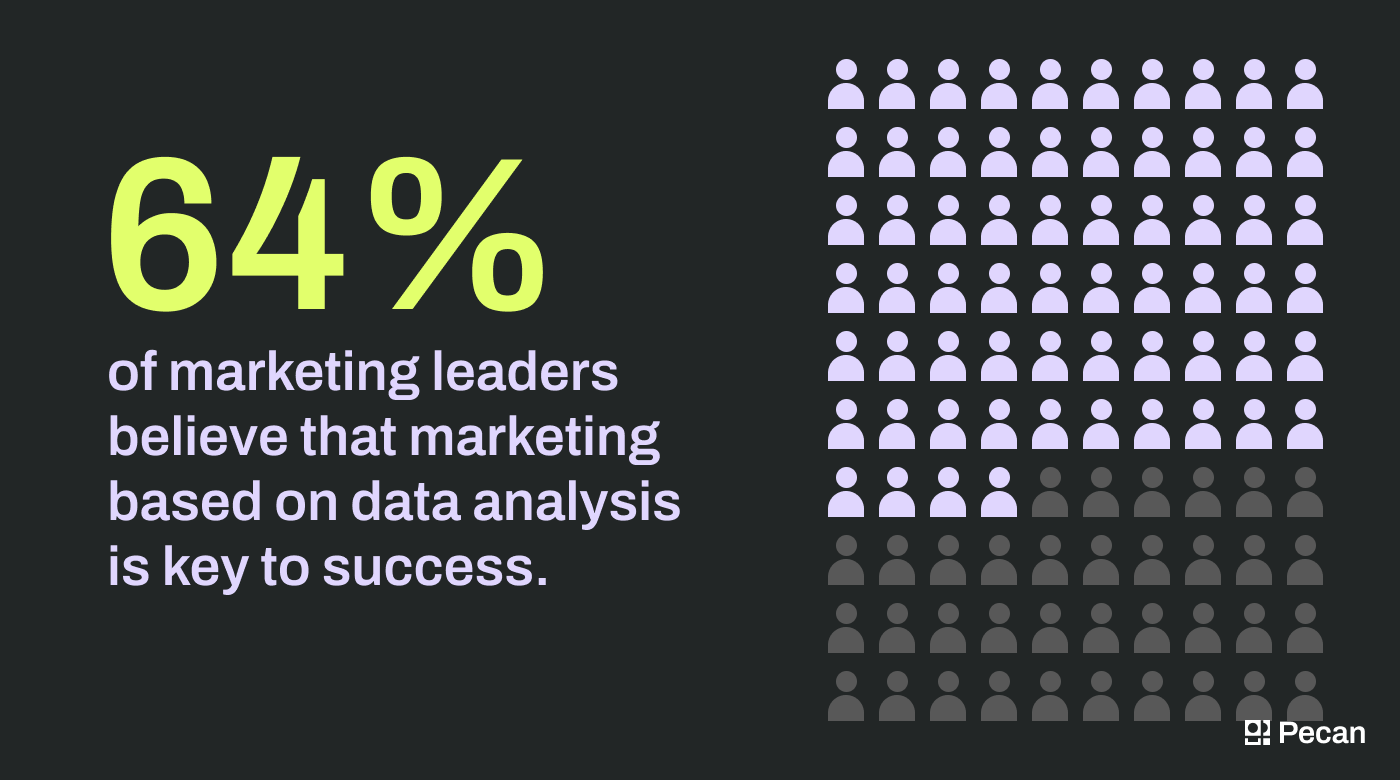In a nutshell:
- Predictive customer analytics helps businesses forecast future customer behavior and market trends.
- It involves using historical data to build predictive models for customer churn, sales trends, and more.
- AI-driven platforms like Pecan automate the process, providing quick and actionable results.
- Benefits include personalized marketing, improved customer experience, and increased revenue growth.
- Considerations include data quality, compliance, and ongoing monitoring for accurate predictions.
Understanding and predicting customer behavior is a major challenge for business owners. However, accurately forecasting future sales and demand — and quickly adapting to market changes — can significantly impact a business's long-term success. So, predicting these changes is crucial during rapidly fluctuating markets and in a highly competitive global economy. Fortunately, predictive customer analytics provides a way to address these challenges and maintain a competitive edge.
This article will examine the meaning of predictive customer analytics, its benefits and limitations, and explore ways to incorporate it into your business.
What is predictive customer analytics?
When looking into the tools and techniques that might work best for your business, it’s important to understand the distinction between general and predictive customer analytics.
General customer analytics involves analyzing historical and current data to understand customer behavior and provide insights into the past or current situation.
Its goal is to understand customer behavior, business performance, and the current state of the business-customer relationship.
Predictive customer analytics, on the other hand, uses historical data to build a predictive model that can forecast future customer behavior, such as:
- Which customers are likely to churn
- What customers are likely to buy
- How sales might trend
How does predictive analytics work?
Predictive customer analytics starts with the collection of customer data. This can include broad trends observed across the customer base and more specific data about individual customer behaviors and demographics.
Once the data is gathered, it’s analyzed using statistical modeling and machine learning methods. Identified patterns can then be used with new data to forecast future customer behaviors and market trends.
Data scientists and analysts can use AI, machine learning, and various predictive modeling techniques to conduct predictive analytics and automate actions as a result of predictions.
AI and predictive customer analytics
Until recently, businesses have hired data scientists to build statistical models, forecast future trends, and carry out predictive analytics. However, hiring data scientists can present some challenges for businesses. For instance, they can be hard to recruit and retain, costly to hire, and slow to produce results. Furthermore, data scientists may not fully understand the business's marketing concerns, leading to a disconnect between data and marketing goals.
More recently, user-friendly, AI-driven analytics platforms have automated many of the complex processes involved in predictive analytics. This means that data analysts can now take on the tasks that data scientists would typically have tackled, and marketers can be directly involved. Consequently, the trend for predictive analytics software is increasing year-on-year. In 2020, the predictive analytics software market was valued at $5.29 billion, and projections suggest it will increase to $41.52 billion by 2028.
Predictive analytics market revenue
Not all AI analytics platforms are alike, however. While some are designed to help interpret past data and trends using spreadsheets and visual aids, other AI-driven predictive analytics platforms, like Pecan, leverage historical data to forecast future outcomes.
AI-driven predictive analytics platforms such as Pecan can automate the process of data analysis, leading to a range of advantages, such as:
- The easy assimilation of highly complex data
- Quick results (weeks instead of months)
- Relevant and actionable results
- No requirement for advanced coding skills
- The automation of model maintenance
- Personalization of customer experiences on a large scale
- Continuous improvement in efficiency and accuracy with machine learning
- A reduction in costs of customer research and marketing campaigns
With an abundance of analytics platforms to choose from, it's important to have a clear understanding of your business's needs to choose the right one. For more information about this, check out Pecan’s guide to choosing the right strategy and platform.
Which companies use predictive analytics?
Many large-scale businesses and multinational corporations such as Amazon, Netflix, and Walmart have been using predictive customer analytics to learn about their customers for many years. For instance, Amazon uses predictive analytics for a range of functions, including:
- Personalized product recommendations
- Inventory management
- Anticipatory shipping
- Dynamic pricing
- Fraud detection
Now, with the reduced costs and greater efficiencies offered by AI-driven predictive analytics platforms, the ability to forecast market trends and customer behaviors is accessible to many more businesses.
The leading mobile entertainment provider, SciPlay, uses Pecan for its marketing predictions. By doing so, it’s gained a more efficient marketing process, enabling it to identify the right players for retargeting. The company saves millions of dollars annually with this improved foresight into player behavior. Moreover, their player’s gaming experience has improved with better-targeted messaging and offers.
What are the benefits and limitations of predictive customer analytics?
The benefits of predictive customer analytics
Predictive customer analytics facilitates data-based decision-making rather than guesswork, leading to better decisions and more effective marketing. About 64% of marketing leaders believe that marketing based on data analysis is key to achieving success in a highly competitive global economy.
Most marketers believe in the power of data.
This approach allows you to deeply understand your customers and deliver personalized marketing experiences. Customers highly value feeling understood, as indicated by the fact that 74% of surveyed customers felt it was more important than receiving discounts for loyalty.
Moreover, data-driven marketing enables better use of marketing resources, resulting in improved return on investment (ROI). Predictions can also help shape various business strategies in marketing, sales, product development, and customer service.
You can create targeted customer segments by anticipating customer behaviors, such as future spending, product preferences, or likelihood of churn. Marketing tailored to the specific needs of these segments can significantly boost effectiveness.
Enhanced customer experience is another major advantage of predictive customer analytics, and personalized marketing typically leads to higher customer satisfaction scores (CX scores). Additionally, it aids in reducing customer churn by identifying high-risk customers, allowing you to use proactive measures to retain them.
All these benefits combined lead to more effective marketing, increased conversion rates, more sales, and accelerated revenue growth.
The limitations of predictive customer analytics
Although predictive customer analytics offers huge benefits, its accuracy and efficiency depend on certain factors, including:
- Quality of data: The accuracy of predictive analytics depends on the quality of the data used, which must be accurate, relevant, and free from errors.
- Quantity of data: More data provides a fuller picture, leading to better predictions.
- Use of appropriate and complete data: This has been a challenge when data scientists and analysts haven’t fully understood a business's marketing goals. Our “State of Predictive Analytics in Marketing” survey found that 37% of marketers have received models based on incomplete or poorly chosen data, resulting in potentially unreliable predictions.
- A clear understanding of marketing goals: The success of a predictive model depends on a clear definition of the marketing objectives it aims to achieve.
- Fast turn-around time: To respond to rapidly changing market conditions, businesses need relevant, actionable results within a short time frame.
- Ongoing monitoring and updating: To reflect current trends and remain accurate, predictive models must be continuously updated with new data.
Although exceptional accuracy is highly desirable, there are other factors to consider, such as speed and agility. For instance, to predict and prevent customer churn, you’ll need predictions as quickly as possible, and you may need to be prepared to compromise a little on accuracy for the sake of agility. Even an imperfect churn model offers considerable benefits, such as one with 80% accuracy. Accurate predictions can significantly improve customer engagement and loyalty by addressing issues before they lead to churn.
Using AI-driven predictive analytics platforms can mitigate many of the limitations listed above and provide much quicker results than other analysis methods.
Privacy compliance
In some countries, privacy laws may limit or prohibit the collection of certain types of customer data for predictive analytics.
For instance, the General Data Protection Regulation (GDPR) in the European Union imposes strict rules on how personal data is collected and used. It also requires explicit consent for data usage.
AI-driven platforms like Pecan can help overcome these challenges by helping marketers combine attribution and marketing mix modeling (MMM) techniques. This combination of analytics techniques addresses marketing needs while reducing reliance on sensitive personal data, allowing businesses to optimize their marketing strategies in a privacy-conscious manner.
13 tips for incorporating predictive customer analytics in your business
In this section, we’ll look at some specific ways in which predictive customer analytics can be used as part of your business strategy.
1. Look-alike modeling: Look-alike marketing targets potential new customers who resemble existing customers. Predictive analytics evaluates the characteristics and behaviors of current customers to accurately identify these “look-alike” customers.
2. Customer segmentation: Predictive analytics examines data to identify distinct customer groups with shared characteristics such as demographics, behavior, and preferences. It then forecasts the specific needs of each segment, enabling businesses to provide more targeted marketing strategies to each group.
AI-driven customer segmentation is a powerful method.
3. Customer cross-sell and upsell: Predictive analytics evaluates previous purchasing patterns to identify customers likely to buy upgraded or additional products.
4. Reducing customer churn: Using predictive analytics, you can forecast why and when a specific customer may churn, then reach out with personalized retention strategies. To explore how Pecan applies predictive analytics to prevent customer churn, book a demo to see these strategies in action.
5. Lifetime value prediction: Predictive analytics enables you to estimate the total value a customer will bring over their entire relationship with the business. Then, you can prioritize your marketing resources toward high-value customers.
6. Sentiment analysis: This allows you to detect positive and negative sentiments within text, for instance, in customer feedback. This data can be used to gain insights into your brand reputation.
7. Demand forecasting: Predict future product demand using historical sales data, seasonal trends, and other factors. This helps you manage your inventory and plan future marketing campaigns.
8. Personalized marketing and product recommendations: Use purchase history and browsing behavior to predict which products will likely interest a customer. Based on this data, personalized recommendations can be made. This is a valuable feature, as personalized marketing is becoming increasingly relevant in today’s market—in 2023, 56% of surveyed consumers stated they'd become repeat buyers from a retailer who provided personalized marketing, compared to 49% in 2022.
Consumers expect personalized marketing today.
9. Optimizing marketing mix: Predict the most effective combination of marketing channels and tactics to maximize return on investment.
10. Lead scoring: Rank prospects according to their perceived value to the business. This allows your sales team to prioritize their leads.
11. Ad targeting and optimization: Optimize your ad budget by predicting which customers will most likely engage with certain advertisements.
12. Data-driven creatives: Predict which design elements, such as color, background, fonts, etc., will be most effective, and design your assets accordingly.
13. Predictive SEO: Analyze historical data and current market trends to predict which keywords, content strategies, and SEO practices will likely be effective.
Some dos and don’ts of predictive customer analytics
Do:
- Understand your data: Thoroughly understand your data, including its source, quality, and relevance, as this will form the foundation of accurate predictive analytics.
- Define your objectives: Be clear about what you hope to achieve with predictive analytics, whether improving customer experience, increasing sales, or optimizing efficiency.
- Ensure data privacy and compliance: Always comply with data protection laws such as GDPR and follow ethical guidelines to maintain customer trust and avoid legal issues.
- Use the right tools: Choose tools that fit your business needs and can handle your specific data types and volumes.
- Act on the results: Integrate the understanding you gain from predictive analytics into your business strategies to make better-informed decisions.
- Be mindful of ethical implications: Consider the ethical implications of using customer data and your predictions.
- Communicate results with relevant stakeholders: Communicate the findings from your predictive analytics with key stakeholders to support informed decision-making.
Don’t:
- Don’t use poor-quality data: the entire premise of predictive analytics is undermined by poor-quality data, leading to inaccurate predictions and poor decisions. Alternatively, if you know your data is a bit messy, choose a tool like Pecan that can automatically tidy and prepare your data for predictive analytics.
- Don’t become complacent: Markets constantly change, so don’t rely on old data and outdated predictive models. Monitor and update models often to ensure you’re working with current information that reflects the present-day market and customer behavior.
Predictive customer analytics FAQ
How can predictive analytics deepen customer relationships?
Predictive analytics help you better understand your customers’ behaviors and needs, now and in the future. With this understanding, you can:
- Provide personalized marketing
- Anticipate the needs of your customers
- Improve your customers’ experience
- Provide better customer support
All these factors contribute to a deeper relationship with your customers.
What is predictive analytics in customer targeting?
Predictive analytics in customer targeting involves data analysis and modeling techniques to identify potential customers most likely to engage with a product or service.
It examines patterns in existing customer data, such as purchasing history and behaviors, to identify these individuals.
This approach allows you to target your marketing to those identified individuals, leading to more effective marketing.
What is an example of predictive analytics?
To illustrate how predictive analytics might work in specific circumstances, we can use the example of a photography retail company. This company could use predictive analytics to upsell and cross-sell to existing customers using the following steps:
- Collection of data such as past purchasing history, browsing history, and demographics of their current customers
- Analysis of the data by data analysts or using predictive analytics software
- Construction of a predictive model based on patterns and trends identified during the analysis
- Identification of potential customers most likely to respond positively to cross-sell or upsell marketing
- Using this information, the company sends personalized recommendations to customers who have bought cameras or other equipment, suggesting accessories that they are likely to purchase.
What is predictive analysis in customer support?
Predictive analytics can give you the information necessary to provide high-quality customer support. Data analysis can be used to anticipate customer support needs, enabling you to offer more proactive, personalized support.
For instance, a telecommunications company might use predictive analytics to monitor customer data usage. Their analysis shows that when a customer has a sudden increase in data usage, they'll typically call within a week to enquire about their charges. So, before these customers experience frustration or confusion, the company proactively sends a personalized email. This explains the reasons for the increased data usage, ways to optimize their data usage, and options for upgrades.
Providing improved customer support in this way has wide-ranging benefits, such as increased customer satisfaction, higher levels of trust in the company, and reduced customer churn.
What are some other benefits of predictive analytics besides customer retention?
The benefits of predictive analytics are wide-reaching and varied. They include:
- Better decision-making: Use data to make smarter choices for your business.
- Efficient use of resources: Predict where best to use your time and money.
- Improved inventory management: Accurate supply and demand forecasting allows you to manage stock levels efficiently.
- Creating better products: Design products that people will want by understanding customer preferences.
- Manage risks: Use data to manage risk in finance and insurance
- Gain more customers: Identify and target potential customers more effectively, increasing customer acquisition.
- Revenue growth: Knowing what appeals to your customers will help you improve your marketing and sell more.
- Better customer experience: Increase customer satisfaction by anticipating their preferences and needs.
Predictive customer analytics with Pecan
Predicting future customer behavior can be challenging, but getting it right is key to keeping up with market changes and staying ahead of the competition. This is where AI-driven software like Pecan can help. You don't need to be a data scientist or know how to code to benefit from Pecan’s powerful features.
Pecan smoothly handles complex, messy data and turns it into clear, actionable predictions, helping you make smarter business decisions.
If you want to see how Pecan works and what it can do for your business, start a free trial or book a demo today.










